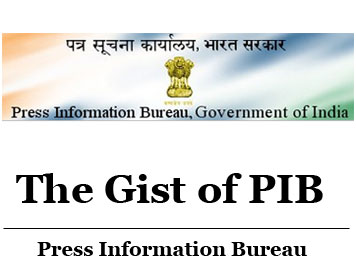(HOT) UPSC Current Affairs 2025 PDF
NEW! The Gist (NOV-2025) | E-BOOKS
(The Gist of PIB) Aerosol characterization and radiative forcing Western-Trans Himalayas [JUNE-2020]

(The Gist of PIB) Aerosol characterization and radiative forcing Western-Trans Himalayas
[JUNE-2020]
Aerosol characterization and radiative forcing Western-Trans Himalayas
-
Researchers at the Aryabhatta Research Institute of Observational Sciences (ARIES), Nainital have found that aerosol radiative forcing larger than the global averages, implying some amount of radiative effects, in spite of the clean atmosphere over the trans-Himalayas.
About:
- ARIES, Nainital is an autonomous research institute under the Department of Science and Technology (DST), Ministry of Science and Technology.
- The Trans-Himalayas Mountain Region is located to the north of the Great Himalayas which consists of Karakoram, Ladakh, Zaskar and Kailash mountain ranges. It is also called the Tibet Himalayan Region because most of the part of these ranges lies in Tibet.
Key highlights of the study:
- The paper under publication in the journal Science of the Total Environment shows that monthly-mean atmospheric radiative forcing of aerosols leads to heating rates of 0.04 to 0.13 C per day.
- Further, the temperature over the Ladakh region is increasing 0.3 to 0.4 degrees Celsius per decades from the last 3 decades.
Significance:
- The atmospheric aerosols play a key role in the regional/global climate system through scattering and absorption of incoming solar radiation and by modifying the cloud structure.
- The transport of light-absorbing carbonaceous aerosols and dust from the polluted Indo-Gangetic Plain and desert areas over the Himalayas constitutes a major climatic issue due to severe impacts on atmospheric warming and glacier retreat.
- This heating over the Himalayas facilitates the “elevated-heat pump” that strengthens the temperature gradient between land and ocean and modifies the atmospheric circulation and the monsoon rainfall.
- A deep scientific study of aerosol generation, transport, and its properties have important implications in the mitigation of climate change.
- The study can help better understand the aerosol optical and microphysical properties and improve the modelling of aerosol effects in view of aerosol-climate implication via modifications in atmospheric warming and changes in the snow/glacier albedo over the trans-Himalayan region.
Background:
- Measurements of aerosol optical and microphysical properties started during the last decade at the Indian Astronomical Observatory (IAO) at the high altitude background sites of Hanle and Merak in the trans-Himalayas under the frameworks of Aerosol Radiative Forcing over India (ARFI) and Astronomical Site Survey program of Indian Institute of Astrophysics (IIA), Bangalore.
- The Indian Astronomical Observatory, located near Leh in Ladakh, has one of the world’s highest located sites for optical, infrared and gamma-ray telescopes.
- In addition to this, few in-situ measurements of carbonaceous aerosols and ionic species have also been performed at Himansh Observatory (Spiti Valley) in the western Himalayas.
CLICK HERE TO DOWNLOAD FULL PDF
Study Material for UPSC General Studies Pre Cum Mains
This is Only Sample Material, To Get Full Materials Buy The Gist 1 Year Subscription - "Only PDF" Click Here
Click Here to Download More Free Sample Material
Courtesy: PIB

